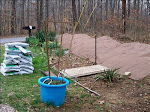Tuesday, August 3, 2010
Second Planting
Fall planting is a wonderful thing, giving us a chance to enjoy Nature’s bounty up until the holidays. Now until Aug 15th is the time to start sowing the seeds for another crop. And while Fall planting is not easy, with care and attention you can have another bumper crop this year.
Most importantly, choose the right plants for the season. Remember, these plants will be fighting extreme heat, low water, full-grown insects, and those ever-present weeds. Near the end of their season the weather will be cold, perhaps rainy, so you want plants that are meant to grow in those conditions. Broccoli, cabbage, snap beans, collards and other greens and lettuces, radishes and potatoes all perform well when planted late in the season.
Follow the directions on the seed packet or plant insert that direct you when to plant. If you live in Nashville, keep in mind that the first frost date is approximately October 29th and count backward accordingly. If the plant requires 60 days to fruition, you want to plant by August 29th or sooner to beat the frost date.
Plants require nitrogen, and fall plants are no exception. Fertilize your seed with nitrogen. Nitrogen is very mobile in the soil, making it subject to leaching and other types of losses, so it has to be replaced. Urban soils are often lacking in nutrients, especially where organic material such as leaves and grass clippings have been constantly removed and not allowed to return nutrients to the soil. Adding compost, leaf mould, animal manures, seaweed, straw, etc. on a regular basis is the best recipe for plant health. A word of warning though: don't incorporate organic matter deeper than 20cm - it can produce gases around the roots of plants and kill them. Organic mulches are great for water conservation and weed control as well. Organic material does however use up nitrogen as it breaks down. A good way of replacing nitrogen is planting a green manure crop of legumes and digging the crop into the soil. Chemical fertilizers allow you to be more scientific and exact in the way you apply nutrients.
All in all, you can plant fall crops with confidence by following the tips mentioned in this article. I relied heavily on the websites listed below and even used some of their words verbatim. Please visit both sites for more extensive info.
http://www.utextension.utk.edu/publications/homeGarden/default.asp
http://www.global-garden.com.au/gardenbegin_soil.htm#More%20Good%20Oil%20on%20Soil
Subscribe to:
Comments (Atom)


















